Your cart is currently empty!
Tag: world of languages
-
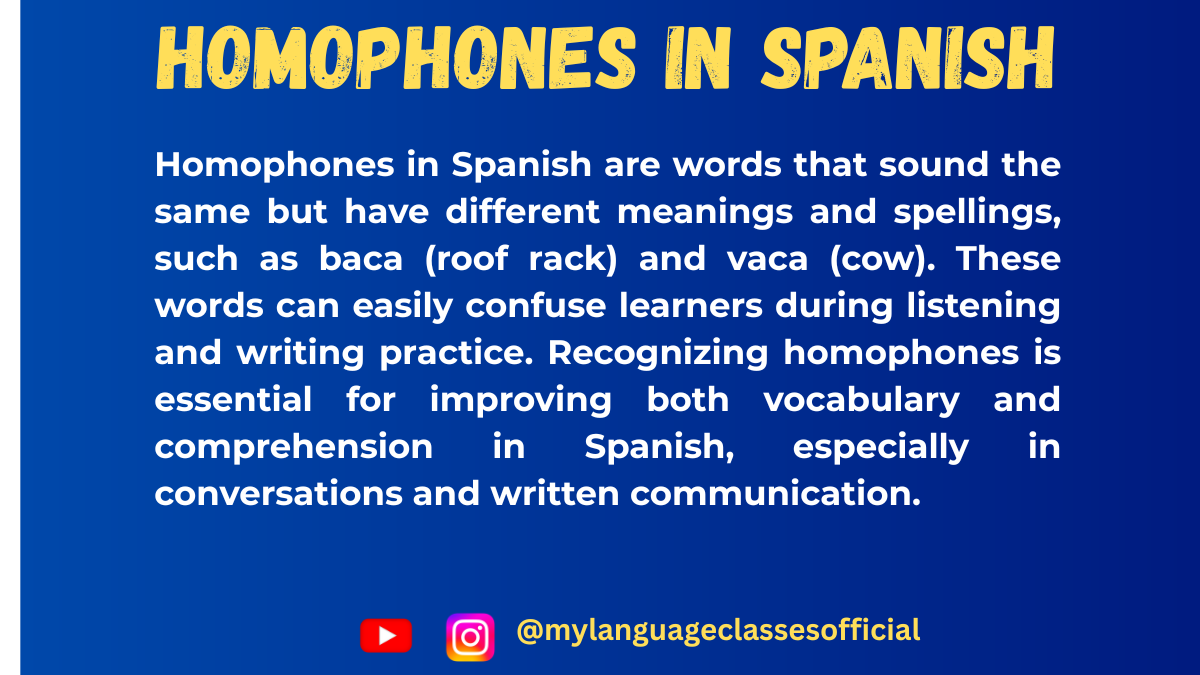
Differentiating Homophones in Spanish: Tú vs. Tu, Él vs. El, and Others
What Are Homophones?
Homophones are words that sound the same but have different meanings and spellings. In Spanish, many homophones exist due to the presence or absence of accent marks (tildes), which change the meaning of a word entirely. Understanding these differences is crucial for mastering Spanish grammar and avoiding misunderstandings in writing and speech.
Common Homophones in Spanish
Below is a list of frequently confused homophones in Spanish, along with their meanings and example sentences.
Homophones Meaning 1 Meaning 2 Example Sentence 1 Example Sentence 2 Tú / Tu (Pronoun) You (Possessive adjective) Your Tú eres muy simpático. (You are very nice.) Tu casa es grande. (Your house is big.) Él / El (Pronoun) He (Article) The Él es mi hermano. (He is my brother.) El coche es rojo. (The car is red.) Más / Mas (Adverb) More (Conjunction) But Quiero más comida. (I want more food.) Quise ir, mas no pude. (I wanted to go, but I couldn’t.) Sí / Si (Adverb) Yes (Conjunction) If Sí, quiero ir. (Yes, I want to go.) Si tienes tiempo, llámame. (If you have time, call me.) Dé / De (Verb) Give (subjunctive) (Preposition) Of, from Quiero que me dé la llave. (I want him to give me the key.) La casa de mi madre es grande. (My mother’s house is big.) Té / Te (Noun) Tea (Pronoun) You (object) Me gusta el té verde. (I like green tea.) Te quiero mucho. (I love you very much.) Aún / Aun (Adverb) Still, yet (Adverb) Even Aún no he terminado. (I haven’t finished yet.) Aun los niños pueden hacerlo. (Even the children can do it.) Solo / Sólo (Adjective) Alone (Adverb) Only (obsolete accent) Me siento solo. (I feel alone.) Sólo quiero una respuesta. (I only want an answer.) Porque / Por qué (Conjunction) Because (Interrogative phrase) Why No fui porque estaba enfermo. (I didn’t go because I was sick.) ¿Por qué estás triste? (Why are you sad?) Qué / Que (Interrogative) What (Conjunction) That ¿Qué quieres? (What do you want?) Dijo que vendría mañana. (He said that he would come tomorrow.)
More Example Sentences
- Tú puedes venir, pero tu hermano no. (You can come, but your brother can’t.)
- Él dijo que el problema está resuelto. (He said that the problem is solved.)
- Quiero más, mas ya no hay comida. (I want more, but there’s no food left.)
- Sí voy a la fiesta, pero si tú vas también. (Yes, I will go to the party, but only if you go too.)
- Es importante que me dé una oportunidad para explicar de qué hablo. (It’s important that he gives me a chance to explain what I’m talking about.)
- Té caliente o frío, como prefieras, pero te recomiendo el de menta. (Hot or cold tea, as you prefer, but I recommend the mint one.)
- Aún estás aquí? No puedo creer que aun después de todo no te hayas ido. (Are you still here? I can’t believe that even after everything, you haven’t left.)
- Está solo en casa, pero sólo hasta las cinco. (He is alone at home, but only until five.)
- No entiendo por qué estás tan cansado, porque dormiste bien. (I don’t understand why you’re so tired, because you slept well.)
- Qué bonito día! No sabía que te gustaba la primavera. (What a beautiful day! I didn’t know that you liked spring.)
Things to Keep in Mind
- Accent marks matter: In Spanish, accents are not optional; they change the meaning of words entirely.
- Articles and gender: Be mindful of definite articles (el, la, los, las) and their relation to nouns.
- Pronouns vs. adjectives/articles: Many homophones differ between being pronouns and adjectives/articles (e.g., tú vs. tu).
- Conjunctions and adverbs: Words like mas and más or aún and aun play different grammatical roles.
Fill in the Blanks
- No sé _______ hacer. (Qué / Que)
- No quiero _______ me hables así. (que / qué)
- _______ tiempo hace hoy? (Qué / Que)
- Me gusta _______ café de tu casa. (el / él)
- _______ quiere ir al cine. (El / él)
- Tienes que _______ las gracias. (dé / de)
- Todavía no lo he visto. Está _______ ocupado. (aún / aun)
- Prefiero tomar _______ en la mañana. (té / te)
- Me gusta mucho _______ casa. (tu / tú)
- _______ es muy simpática. (Tú / Tu)
Answers:
- Qué 2. que 3. Qué 4. el 5. él 6. dé 7. aún 8. té 9. tu 10. Tú
Conclusion
Mastering Spanish homophones is essential for both speaking and writing correctly. Paying attention to accent marks, sentence context, and grammatical functions will help avoid misunderstandings. Keep practicing, and soon differentiating these words will become second nature!
Thank you for reading this comprehensive guide.
To keep improving your Spanish skills and exploring more language tips, please:
- Visit: mylanguageclassesblog.wordpress.com
- Follow on Instagram: My Language Clases
- Subscribe on YouTube: My Language Classes Channel
Stay curious, keep practicing, and enjoy your language learning journey!
- 100 Spanish Example Sentences
- 100 Spanish Fill-in-the-Blanks Exercises
- 100 Spanish Vocabulary Lists
- Spanish – Advanced
- Spanish – Beginner
- Spanish – Intermediate
-
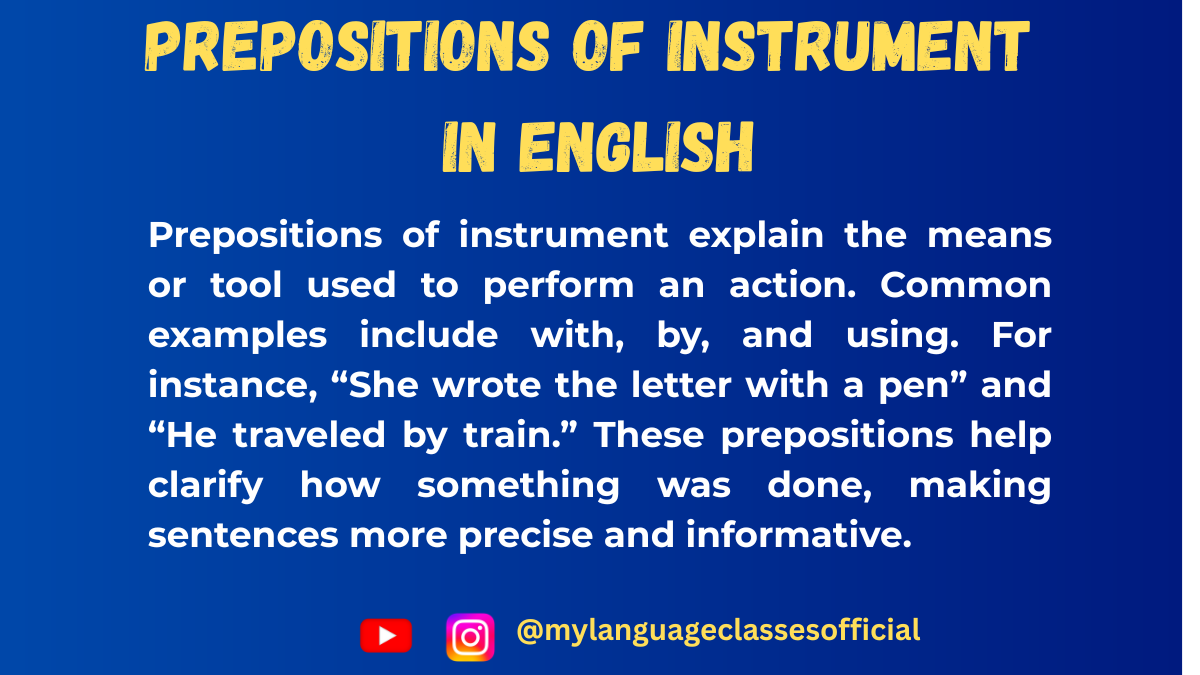
Prepositions of Instrument in English
Prepositions of instrument are used to indicate the means or tools used to perform an action. These prepositions show how something happens or is achieved. They are crucial in English grammar, as they help provide clarity in sentences.
Usage of Prepositions of Instrument
Prepositions of instrument are used in various situations, such as:
- With Tools or Instruments – Used when referring to a tool or instrument that helps complete an action.
- With Modes of Transport – Used when talking about how someone travels.
- With Means of Communication – Used when referring to ways of sending or receiving information.
- With Body Parts – Used when describing actions performed using body parts.
- With Natural Forces – Used when mentioning how something is affected by nature.
- With Materials or Substances – Used to describe the material used to create something.
- With Assistance – Used when referring to a person or thing that helps achieve something.
- With Measurement and Currency – Used when expressing amounts or ways of measuring.
List of Prepositions of Instrument
Preposition Example Sentence 1 Example Sentence 2 by She wrote the letter by hand. He traveled by car. with He cut the paper with scissors. She painted the wall with a brush. through They communicated through email. The water flows through the pipe. using He solved the problem using a calculator. She opened the door using a key. by means of The data was transferred by means of a USB drive. He escaped by means of a secret tunnel. via The message was sent via email. We traveled via London. on She swore on her mother’s life. He played a song on the piano. in The message was written in ink. She expressed her feelings in words. through the use of The document was signed through the use of an electronic pen. The problem was solved through the use of technology. by way of They reached the village by way of the river. He sent the package by way of courier.
More Example Sentences
- She cut the vegetables with a sharp knife.
- He sent me a message via WhatsApp.
- The report was written in pencil.
- We traveled to the city by train.
- He operates the machine using a remote control.
- She delivered the speech through a microphone.
- The bridge collapsed by means of an explosion.
- The poem was written on a piece of parchment.
- The artist sketched the portrait with charcoal.
- They recorded the lecture through the use of a digital recorder.
Fill in the Blanks
- He fixed the broken chair ___ a hammer.
- She traveled to Paris ___ plane.
- The students communicated ___ email.
- He ate the soup ___ a spoon.
- The announcement was made ___ a loudspeaker.
- The letter was written ___ a ballpoint pen.
- They cut the paper ___ scissors.
- The transaction was completed ___ an online payment system.
- The thief entered the house ___ a secret passage.
- The message was transmitted ___ radio waves.
Answers
- with
- by
- through
- with
- through
- in
- with
- using
- by means of
- via
Things to Keep in Mind
- Prepositions of instrument often indicate the method, means, or tools used to perform an action.
- Some prepositions, like by and with, are commonly interchangeable but depend on context.
- The choice of preposition can sometimes depend on the verb in the sentence.
- Articles (a, an, the) may be required before the instrument (e.g., “with a knife”).
- Gender does not play a role in English prepositions, unlike some other languages.
Conclusion
Prepositions of instrument are essential in English to convey how actions are performed. Understanding their correct usage will help improve clarity and precision in communication. By mastering these prepositions, learners can express themselves more effectively in various situations, whether discussing tools, travel, communication, or assistance.
If you enjoyed this lesson, be sure to check out more posts like this on my blog at My Language Classes. Don’t forget to subscribe my YouTube channel and follow me on Instagram for the latest language learning tips and lessons. Leave a comment below to share your thoughts, or ask any questions you have about nouns.
Happy learning! 😊
-
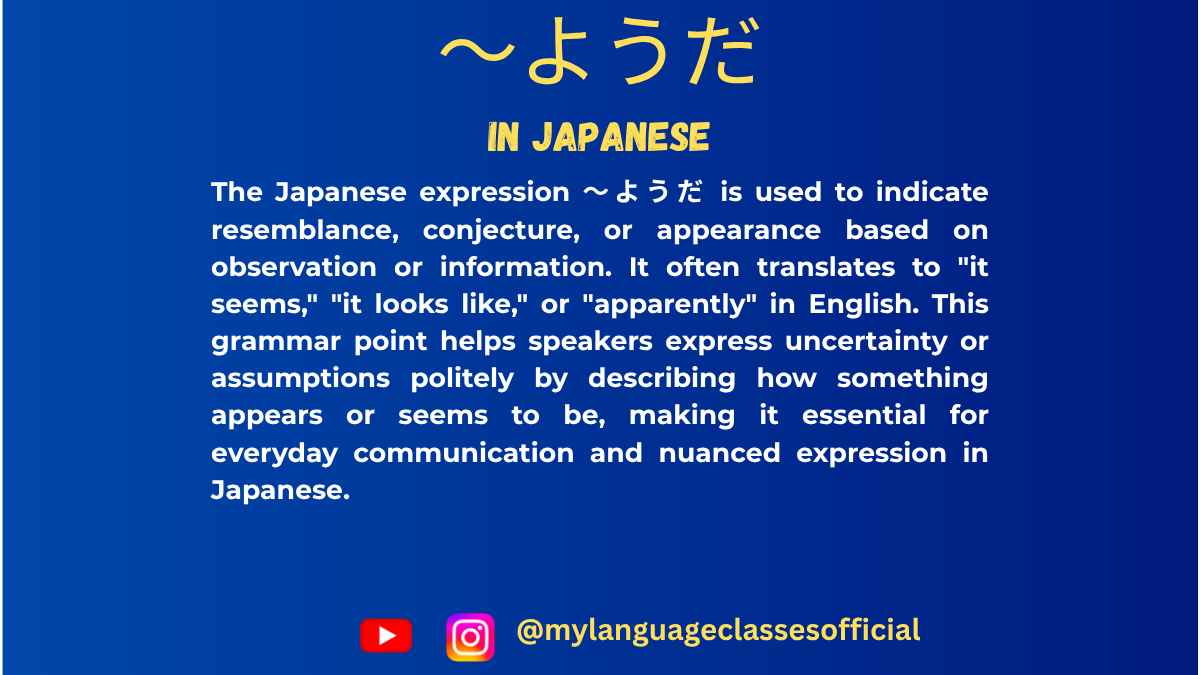
Understanding 〜ようだ in Japanese | My Language Classes
Understanding 〜ようだ in Japanese
The Japanese expression 〜ようだ (you da) is used to indicate resemblance, assumption, or conjecture based on observable evidence. It often translates to “seems like,” “appears to be,” or “looks like” in English. This form is frequently used in both spoken and written Japanese to express an impression based on visual or contextual clues rather than firsthand knowledge.
Formation of 〜ようだ
1. With Verbs:
- Formation:
- Verb (dictionary form) + ようだ
- Verb (ta-form) + ようだ (past tense)
2. With Nouns:
- Formation:
- Noun + のようだ
3. With Adjectives:
- i-Adjectives:
- Adjective (plain form) + ようだ
- na-Adjectives:
- Adjective (stem) + なようだ
Usage of 〜ようだ
- Expressing Appearance – Used when something visually appears a certain way.
- Expressing Similarity – Used to compare something to another thing.
- Expressing Assumption – Used to make an educated guess based on observed facts.
- Expressing Uncertainty – Used to indicate something that is not confirmed.
Situations where 〜ようだ is used
- When making an assumption based on visual clues.
- When describing a person’s behavior resembling something.
- When comparing one thing to another.
- When describing a feeling or state that is not directly observable.
- When indicating a metaphorical expression.
Examples of Verbs, Nouns, and Adjectives with 〜ようだ
Word Type Base Word 〜ようだ Form Example Sentence Romaji Meaning Verb 食べる (taberu) 食べるようだ あの子はよく食べるようだ。 Ano ko wa yoku taberu you da. That child seems to eat a lot. Verb 雨が降る (ame ga furu) 雨が降るようだ 突然暑くなったから雨が降るようだ。 Totsuzen atsuku natta kara ame ga furu you da. It suddenly got hot, so it looks like it’s going to rain. Verb 走る (hashiru) 走るようだ 子供が快速に走るようだ。 Kodomo ga kaisoku ni hashiru you da. The child seems to be running fast. Noun 神様 (kami-sama) 神様のようだ 他の行動は神様のようだ。 Kare no koudou wa kami-sama no you da. His actions are like those of a god. Adjective 青い (aoi) 青いようだ 水が青いようだ。 Mizu ga aoi you da. The water seems to be blue.
More Example Sentences
- 他の思い通りのようだ。
Tano omoi doori no you da. (It seems to be just as he thought.) - 子供はおなかがすいたようだ。
Kodomo wa onaka ga suita you da. (The child seems to be hungry.) - 家の外は非常に冷たいようだ。
Ie no soto wa hijou ni tsumetai you da. (It seems to be extremely cold outside.)
Things to Keep in Mind
- 〜ようだ is different from 〜そうだ, which is used for hearsay or direct appearance.
- It cannot be used for one’s own direct experiences.
- 〜ようだ can be formal or casual depending on context.
Fill in the Blanks
- 大きな壁が倒れる\u_____
- その人はエンジニア\uの\u_____
- 雨が降りそう\u_____
- 私の猫は子猫の\u_____
- その子は疲れている\u_____
- その風は強い\u_____
- かれの勝利は確実の_____
Answers
- ようだ
- ようだ
- ようだ
- ようだ
- ようだ
- ようだ
- ようだ
Conclusion
〜ようだ is a crucial structure in Japanese that allows speakers to express assumptions, resemblance, and indirect knowledge. Mastering this form helps in making more natural and nuanced statements in Japanese conversations and writing.
If you enjoyed this lesson, be sure to check out more posts like this on my blog at My Language Classes. Don’t forget to subscribe my YouTube channel and follow me on Instagram for the latest language learning tips and lessons. Leave a comment below to share your thoughts, or ask any questions you have about nouns.
Happy learning! 😊
- Formation:
-
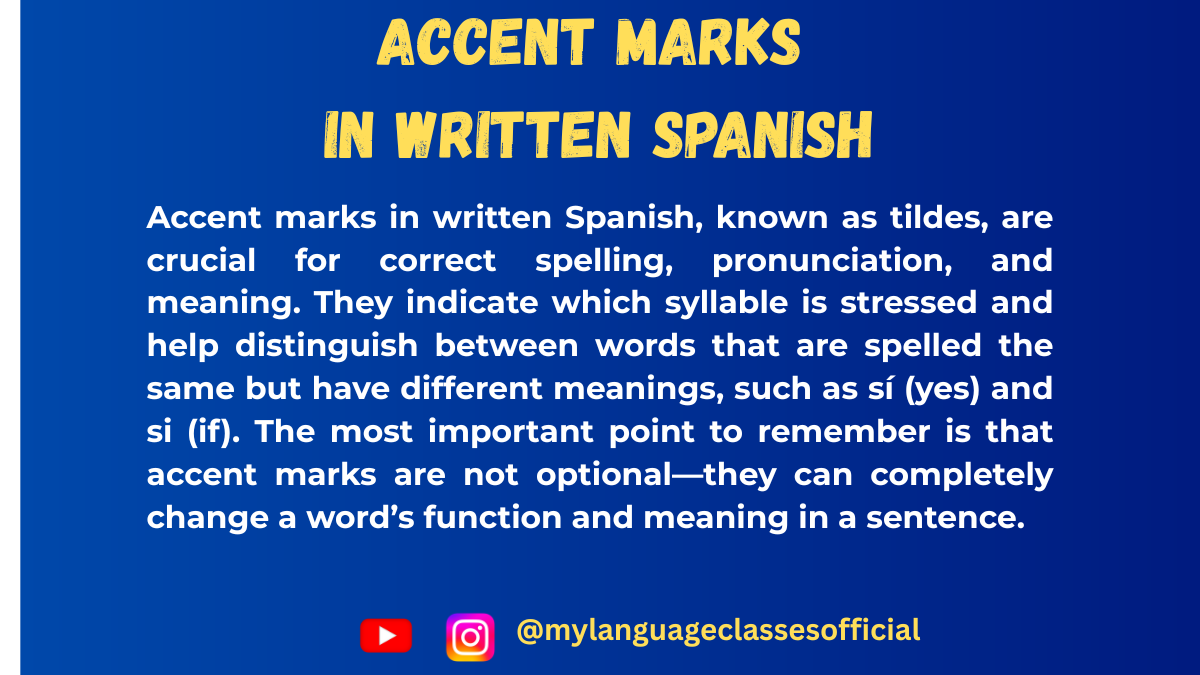
Correct Use of Accent Marks in Written Spanish
Spanish is a phonetic language, meaning words are pronounced as they are written. However, the correct use of accent marks (tildes) is crucial to ensuring clarity and avoiding misunderstandings. Accent marks in Spanish are not just decorative; they indicate stress and, in some cases, distinguish words that are otherwise spelled the same but have different meanings. Let’s explore how to use accent marks correctly and why they are so important.
The Importance of Accent Marks in Written Spanish
Accent marks can completely change the meaning of a word. For example:
- tú (you) vs. tu (your)
- Tú tienes un coche nuevo. (You have a new car.)
- Tu coche es nuevo. (Your car is new.)
- sí (yes) vs. si (if)
- Sí, quiero ir al cine. (Yes, I want to go to the movies.)
- Si quieres, podemos ir al cine. (If you want, we can go to the movies.)
- más (more) vs. mas (but)
- Quiero más azúcar en mi café. (I want more sugar in my coffee.)
- Quería ir, mas no pude. (I wanted to go, but I couldn’t.)
As you can see, missing an accent mark or placing one where it doesn’t belong can lead to confusion and change the meaning of a sentence entirely.
Rules for Using Accent Marks in Spanish
1. Words That Follow Natural Stress Rules (No Accent Mark Needed)
Spanish words naturally follow two stress rules:
- If a word ends in a vowel, ‘n’, or ‘s’, the stress falls on the second-to-last syllable.
- Example: casa (house), lápices (pencils), comen (they eat)
- If a word ends in any other consonant (except ‘n’ or ‘s’), the stress falls on the last syllable.
- Example: hotel (hotel), reloj (watch)
When words do not follow these natural stress rules, an accent mark is needed.
2. Words That Break the Natural Stress Rules (Require an Accent Mark)
- Example: canción (song), teléfono (telephone), inglés (English)
3. Differentiating Homonyms (Diacritical Marks)
Certain words have the same spelling but different meanings, distinguished by an accent mark:
- tú (you) vs. tu (your)
- sí (yes) vs. si (if)
- éste (this one) vs. este (this)
- qué (what) vs. que (that)
Example Sentences:
- ¿Qué quieres hacer? (What do you want to do?)
- Dijo que vendría. (He said that he would come.)
4. Interrogative and Exclamatory Words Need an Accent
Question words always have an accent mark:
- ¿Cómo te llamas? (What’s your name?)
- ¡Qué sorpresa! (What a surprise!)
5. Monosyllabic Words Usually Do Not Carry an Accent
Single-syllable words generally do not take an accent, except when distinguishing homonyms:
- tú (you) vs. tu (your)
- mí (me) vs. mi (my)
6. Accent Marks in Verb Forms
Verbs in the preterite and commands often require accents:
- está (he/she/it is) vs. esta (this)
- dé (give) vs. de (of, from)
Things to Keep in Mind
- Accent marks are essential and can change the meaning of a word completely.
- Follow natural stress rules and apply accents when needed.
- Learn and memorize common homonyms with accents.
- Question words always require an accent.
- Verb forms often require accents to maintain clarity.
Fill in the Blanks
- ___ (Tu/Tú) eres muy amable.
- No sé ___ (si/sí) puedo ir mañana.
- Me gusta este libro, pero prefiero ___ (aquel/aquél).
- No entiendo qué quiere decir ___ (mas/más).
- Voy a comprar ___ (mi/mí) coche nuevo.
- ¿___ (Que/Qué) hora es?
- Espero que Juan me ___ (dé/de) un consejo.
- No sé si ella está aquí ___ (aun/aún).
- ¿Te gusta el ___ (café/cafe)?
- Mi hermano siempre ___ (está/esta) ocupado.
Answers
- Tú eres muy amable.
- No sé si puedo ir mañana.
- Me gusta este libro, pero prefiero aquel.
- No entiendo qué quiere decir más.
- Voy a comprar mi coche nuevo.
- ¿Qué hora es?
- Espero que Juan me dé un consejo.
- No sé si ella está aquí aún.
- ¿Te gusta el café?
- Mi hermano siempre está ocupado.
Conclusion
Mastering accent marks in Spanish is essential for clear communication. A missing or misplaced accent can change the meaning of a word completely and lead to confusion. By understanding the rules and practicing regularly, you can improve your written Spanish and avoid common mistakes. Always double-check accent marks, especially in homonyms and verbs, to ensure your writing is accurate and professional. ¡Buena suerte!
If you enjoyed this lesson, be sure to check out more posts like this on my blog at My Language Classes. Don’t forget to subscribe my YouTube channel and follow me on Instagram for the latest language learning tips and lessons. Leave a comment below to share your thoughts, or ask any questions you have.
Happy learning! 😊
- tú (you) vs. tu (your)
-
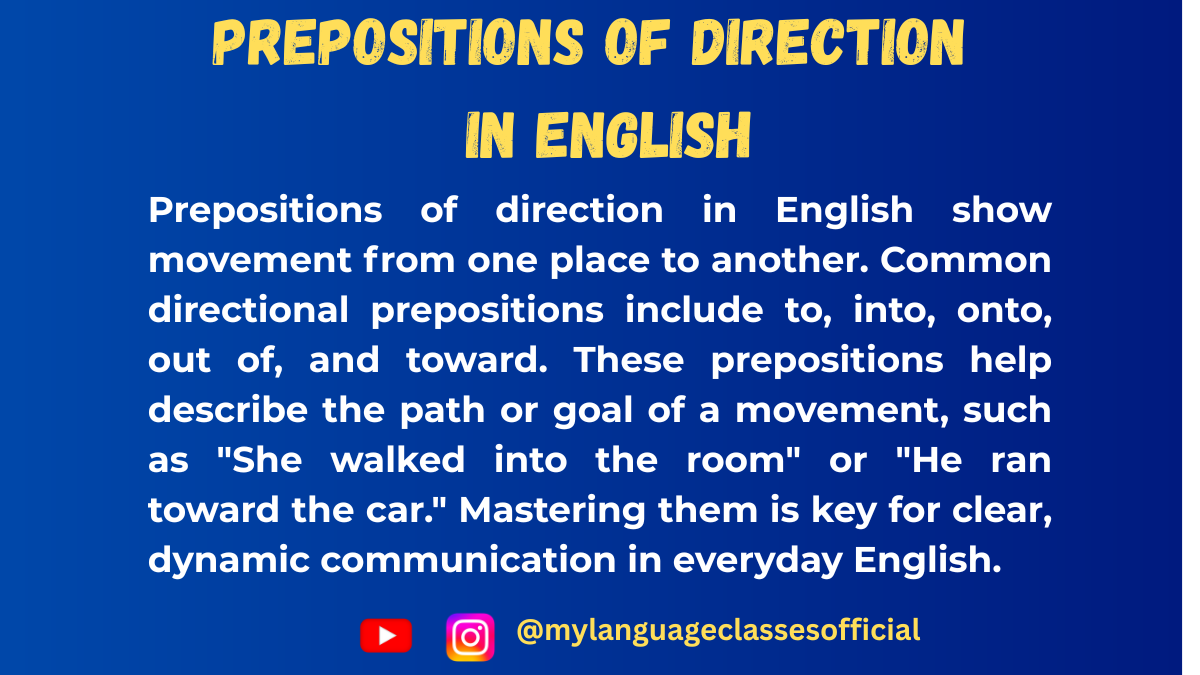
Prepositions of Direction in English
Prepositions of direction indicate movement from one place to another. They are essential in describing how something moves or changes position concerning another object.
List of Prepositions of Direction and Their Usage
Preposition Meaning Example Sentence 1 Example Sentence 2 To Movement towards a destination She went to the park. He sent a letter to his friend. Into Movement from outside to inside She walked into the room. The cat jumped into the box. Onto Movement towards a surface The child climbed onto the table. He jumped onto the bed. Out of Movement from inside to outside She ran out of the house. He took his phone out of his pocket. Towards Movement in the direction of something She moved towards the door. He walked towards me with a smile. Away from Movement in the opposite direction She walked away from the fire. The dog ran away from the stranger. Up Movement from a lower position to a higher one He climbed up the hill. The plane soared up into the sky. Down Movement from a higher position to a lower one The ball rolled down the hill. She walked down the stairs. Across Movement from one side to another He swam across the river. The children ran across the street. Over Movement above something The bird flew over the lake. He jumped over the fence. Under Movement beneath something The dog crawled under the table. The ball rolled under the chair. Along Movement following a path He walked along the beach. The car drove along the highway. Past Movement beyond a certain point They walked past the school. He drove past the mall. Through Movement within a space from one end to another She ran through the tunnel. The wind blew through the trees. Around Movement in a circular direction He walked around the park. The car drove around the roundabout.
More Example Sentences
- The boy ran to his mother as soon as he saw her.
- She poured the coffee into the cup carefully.
- He jumped onto the boat from the dock.
- The cat ran out of the house when the door was open.
- The athlete sprinted towards the finish line.
- They moved away from the dangerous area.
- The monkey climbed up the tree quickly.
- She walked down the street, enjoying the fresh air.
- He drove across the city to meet his friend.
- The plane flew over the mountains.
Fill in the Blanks
- She jumped ___ the swimming pool.
- He walked ___ the tunnel to reach the other side.
- The dog ran ___ the street to chase the cat.
- The helicopter flew ___ the buildings.
- He climbed ___ the ladder to fix the roof.
- The train passed ___ the bridge.
- The girl moved ___ the stage to receive her award.
- The kids walked ___ the road to reach school.
- The car drove ___ the highway without stopping.
- He ran ___ the hill with great speed.
Answers:
- into
- through
- across
- over
- up
- over
- towards
- across
- along
- down
Things to Keep in Mind
- Prepositions of direction always describe movement from one place to another.
- Some prepositions like to and towards may seem similar but have different uses (e.g., “to” specifies the destination, while “towards” indicates movement in a direction without necessarily reaching the destination).
- Prepositions such as into and onto describe entering or moving onto a surface, while in and on describe static positions.
- Over and under describe movement above and below something, respectively.
- Across and through both describe movement, but “across” is typically for flat surfaces, while “through” indicates movement within an enclosed space.
Conclusion
Prepositions of direction are essential for clear communication when describing movement and changes in position. Understanding their proper usage will enhance both written and spoken English. By practicing these prepositions in different contexts, you can develop a natural sense of their application and improve your fluency. Keep practicing with more sentences and exercises to master this important grammar topic!
If you enjoyed this lesson, be sure to check out more posts like this on my blog at My Language Classes. Don’t forget to subscribe my YouTube channel and follow me on Instagram for the latest language learning tips and lessons. Leave a comment below to share your thoughts, or ask any questions you have about nouns.
Happy learning! 😊
-
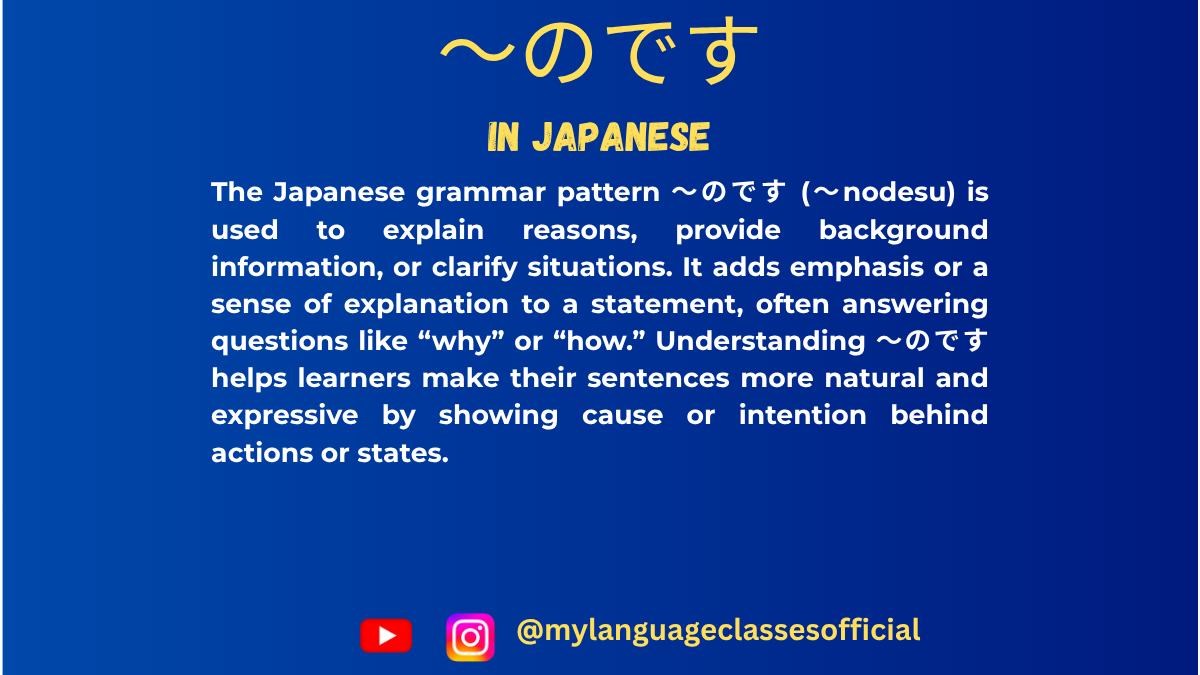
Understanding 〜のですin Japanese | My Language Classes
Understanding 〜のです in Japanese
The 〜のです (or its casual form 〜んです) is a grammatical structure in Japanese used to give explanations, seek clarifications, or express emotions. It adds a sense of reasoning to a statement and is often used in both spoken and written Japanese.
Formation of 〜のです
1. Formation with Verbs
- Affirmative (Present/Future):
- Dictionary form + のです / んです
- Example: 食べるのです (taberu no desu)
- Negative (Present/Future):
- ない-form + のです / んです
- Example: 食べないのです (tabenai no desu)
- Past Affirmative:
- た-form + のです / んです
- Example: 食べたのです (tabeta no desu)
- Past Negative:
- なかった-form + のです / んです
- Example: 食べなかったのです (tabenakatta no desu)
2. Formation with Nouns
- Affirmative:
- Noun + なのです / なんです (casual)
- Example: 学生なのです (gakusei nano desu)
- Negative:
- Noun + ではないのです / じゃないんです (casual)
- Example: 学生ではないのです (gakusei dewa nai no desu)
3. Formation with Adjectives
- i-Adjectives:
- そのまま + のです / んです
- Example: うれしいのです (ureshii no desu)
- Negative: うれしくないのです (ureshikunai no desu)
- na-Adjectives:
- な + のです / んです
- Example: 静かなのです (shizuka nano desu)
- Negative: 静かではないのです (shizuka dewa nai no desu)
Usage of 〜のです
The 〜のです form is used in various situations. Below are the key contexts in which it is used:
1. Providing an Explanation
This form is often used to explain reasons behind actions or situations.
- Example: どうして遅れたのですか? (Why were you late?)
- Example: 雨が降っていたのです。(It was raining.)
2. Seeking Clarification or Confirmation
When you are trying to confirm or seek clarification about something.
- Example: その本はあなたのものなのですか? (Is that book yours?)
3. Expressing a Justification
To justify an action or event.
- Example: 宿題が多かったのです。(I had a lot of homework.)
4. Making a Statement More Emphatic
Using のです makes the statement more formal or assertive.
- Example: 私が行くのです。(I will go.)
5. Stating a Fact with Emphasis
- Example: これはとても大切なのです。(This is very important.)
Other Usage of 〜のです
Situations where 〜のです is used
- Giving explanations or reasons
- Asking for explanations or clarifications
- Expressing emotions such as surprise or concern
- Emphasizing a statement
- Giving background information
- Making an indirect request
- Softening a statement
- Seeking confirmation
- Expressing curiosity
- Describing an unusual situation
List of Verbs with their 〜のです Form
Verb (Dictionary Form) 〜のです Form Example Sentence 1 Romaji Meaning Example Sentence 2 Romaji Meaning 食べる (taberu) 食べるのです これは毎日食べるのです。 Kore wa mainichi taberu no desu. I eat this every day. 彼は魚を食べるのですか? Kare wa sakana o taberu no desu ka? Does he eat fish? 行く (iku) 行くのです 学校へ行くのです。 Gakkou e iku no desu. I am going to school. どこへ行くのですか? Doko e iku no desu ka? Where are you going? 来る (kuru) 来るのです 明日、彼が来るのです。 Ashita, kare ga kuru no desu. He is coming tomorrow. どうして来るのですか? Doushite kuru no desu ka? Why is he coming? 見る (miru) 見るのです 彼はテレビを見るのです。 Kare wa terebi o miru no desu. He watches TV. 何を見ているのですか? Nani o mite iru no desu ka? What are you watching? 書く (kaku) 書くのです 彼女は日記を書くのです。 Kanojo wa nikki o kaku no desu. She writes a diary. 何を書いているのですか? Nani o kaite iru no desu ka? What are you writing? 話す (hanasu) 話すのです 先生は日本語を話すのです。 Sensei wa nihongo o hanasu no desu. The teacher speaks Japanese. 彼と何を話していたのですか? Kare to nani o hanashite ita no desu ka? What were you talking about with him? 買う (kau) 買うのです 私は新しい車を買うのです。 Watashi wa atarashii kuruma o kau no desu. I will buy a new car. 何を買ったのですか? Nani o katta no desu ka? What did you buy? 泳ぐ (oyogu) 泳ぐのです 彼は毎朝泳ぐのです。 Kare wa maiasa oyogu no desu. He swims every morning. どこで泳ぐのですか? Doko de oyogu no desu ka? Where do you swim? 勉強する (benkyou suru) 勉強するのです 私は毎日日本語を勉強するのです。 Watashi wa mainichi nihongo o benkyou suru no desu. I study Japanese every day. 何を勉強しているのですか? Nani o benkyou shite iru no desu ka? What are you studying? 働く (hataraku) 働くのです 彼は銀行で働くのです。 Kare wa ginkou de hataraku no desu. He works at a bank. どこで働いているのですか? Doko de hataraite iru no desu ka? Where do you work? 走る (hashiru) 走るのです 彼は毎朝公園で走るのです。 Kare wa maiasa kouen de hashiru no desu. He runs in the park every morning. どのくらい走るのですか? Dono kurai hashiru no desu ka? How far do you run? 歌う (utau) 歌うのです 彼女はとても上手に歌うのです。 Kanojo wa totemo jouzu ni utau no desu. She sings very well. どんな歌を歌うのですか? Donna uta o utau no desu ka? What kind of songs do you sing? 覚える (oboeru) 覚えるのです 私は新しい単語を覚えるのです。 Watashi wa atarashii tango o oboeru no desu. I memorize new words. どうやって覚えるのですか? Dou yatte oboeru no desu ka? How do you memorize them? 遊ぶ (asobu) 遊ぶのです 子供たちは公園で遊ぶのです。 Kodomotachi wa kouen de asobu no desu. The children play in the park. どこで遊ぶのですか? Doko de asobu no desu ka? Where do they play?
More Example Sentences
- 明日はテストがあるのです。
Ashita wa tesuto ga aru no desu.
(There is a test tomorrow.) - 彼女は病気なのです。
Kanojo wa byouki na no desu.
(She is sick.) - この本は大切なのです。
Kono hon wa taisetsu na no desu.
(This book is important.)
4. 彼は昨日学校を休んだのです。
Kare wa kinō gakkō o yasunda no desu.
(He was absent from school yesterday.)5. どうしてそんなに疲れているのですか?
Dōshite sonna ni tsukarete iru no desu ka?
(Why are you so tired?)6.この時計は祖父からもらったのです。
Kono tokei wa sofu kara moratta no desu.
(I received this watch from my grandfather.)7. 彼女は日本に行くのです。
Kanojo wa Nihon ni iku no desu.
(She is going to Japan.)8. 電車が遅れたのです。
Densha ga okureta no desu.
(The train was delayed.)9.その映画はとても感動的だったのです。
Sono eiga wa totemo kandō-teki datta no desu.
(That movie was very emotional.)10.雨が降っていたのです。
Ame ga futte ita no desu.
(It was raining.)
Things to Keep in Mind
- のです is often shortened to んです in spoken language.
- It is more polite and formal than a direct statement.
- Used in interrogative sentences to seek more information.
- Often used in written explanations and discussions.
Fill in the Blanks
- なぜ学校を休んだ____?
- 彼女は来ない____。
- 私は先生に質問した____。
- どうして泣いている____か?
- 彼は何も言わなかった____。
- あなたが怒っているのは知っている____。
- 昨日、帰りが遅くなった____。
- この本を読んだことがある____か?
- 今日は早く寝たほうがいい____よ。
- 彼がそんなことをするはずがない____。
Conclusion
The 〜のです form is an essential grammar structure that allows Japanese speakers to explain reasons, seek clarifications, and emphasize statements naturally. Mastering its usage will significantly improve your fluency in Japanese communication. Practice using のです in different situations, and you’ll soon find yourself speaking more like a native!
If you enjoyed this lesson, be sure to check out more posts like this on my blog at My Language Classes. Don’t forget to subscribe my YouTube channel and follow me on Instagram for the latest language learning tips and lessons. Leave a comment below to share your thoughts, or ask any questions you have about nouns.
Happy learning! 😊
- Affirmative (Present/Future):
-
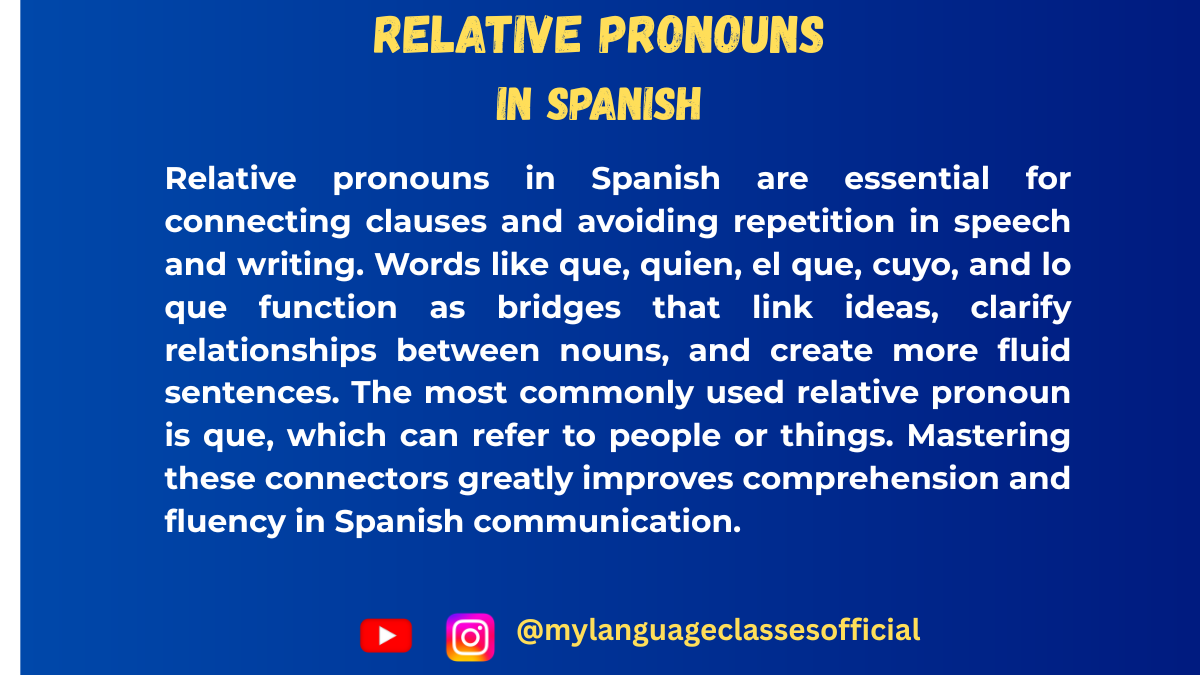
Relative Pronouns in Spanish: Que, Quien, Donde, and Others
When learning Spanish, relative pronouns are essential for connecting sentences smoothly and making speech more fluid. These pronouns allow us to refer to people, places, or things without unnecessary repetition. In this blog post, we will explore the different relative pronouns in Spanish, their meanings, and how to use them correctly.
List of Relative Pronouns in Spanish
Relative pronouns in Spanish are used to introduce subordinate clauses and refer to a previously mentioned noun (antecedent). Below is a list of the most common relative pronouns, their meanings, and example sentences:
Relative Pronoun Meaning Example Sentence 1 Example Sentence 2 Que That, which, who La casa que compré es muy grande. La película que vimos fue interesante. Quien / Quienes Who, whom Mi amiga, quien vive en Madrid, me visitó ayer. Los estudiantes, quienes aprobaron, celebraron. Cuyo / Cuya / Cuyos / Cuyas Whose El hombre cuyo coche es rojo está aquí. La chica cuya madre es doctora es mi amiga. Donde Where La ciudad donde nací es hermosa. Este es el restaurante donde cenamos anoche. El que / La que / Los que / Las que The one(s) who/that El libro, el que compraste, es interesante. Las chicas, las que llegaron tarde, son mis amigas. El cual / La cual / Los cuales / Las cuales The one(s) who/that (formal) La casa en la cual crecí está en ruinas. Los estudiantes, los cuales fueron premiados, estaban felices. Lo que What, which No entiendo lo que dijiste. Lo que más me gusta es viajar. Lo cual Which (referring to a whole idea) Perdimos el tren, lo cual fue un problema. Llegó tarde, lo cual nos molestó mucho. Cuanto / Cuanta / Cuantos / Cuantas As much/many as Toma cuanto quieras. Cuantas veces lo intentó, falló. More Example Sentences
- La mujer que trabaja en la tienda es muy amable.
- Mi amigo, quien es muy inteligente, siempre me ayuda.
- El perro cuyo dueño es mi vecino es muy juguetón.
- No entiendo lo que está pasando.
- El país donde nací es hermoso.
- Los estudiantes, los cuales estudian mucho, sacaron buenas notas.
- La casa en la que crecí tiene muchos recuerdos.
- No sé lo que quieres decir.
- Las flores que compraste son muy bonitas.
- La ciudad donde vivo tiene muchas atracciones turísticas.
Things to Keep in Mind
- Agreement in Gender and Number:
- “Cuyo” agrees in gender and number with the noun it modifies: El hombre cuyos hijos estudian aquí…
- “El que, la que, los que, las que” also change according to the noun they refer to.
- Use of Articles:
- “El cual, la cual, los cuales, las cuales” often appear with a preposition and are more formal.
- “Lo que” and “lo cual” refer to entire ideas or situations.
- Que vs. Quien:
- “Que” is used for both people and objects.
- “Quien” is used mainly for people and must match singular or plural (quien/quienes).
- Where to Use Relative Pronouns:
- “Donde” is for places.
- “Lo que” and “lo cual” refer to abstract concepts.
- “Cuyo” means “whose” and agrees with the possessed noun.
Fill in the Blanks
- La chica _______ vive al lado es muy simpática.
- El perro _______ dueño es mi vecino ladra mucho.
- No entiendo _______ dices.
- La ciudad _______ naciste es hermosa.
- Mi amigo, _______ es doctor, trabaja en el hospital.
- Las flores, _______ compraste ayer, están muy bonitas.
- Juan, _______ hermano es mi compañero, me ayudó con la tarea.
- La razón por _______ llegamos tarde fue el tráfico.
- No sabía _______ querías decir.
- El edificio _______ ventanas son grandes es nuevo.
Answers
- que
- cuyo
- lo que
- donde
- quien
- las que
- cuyo
- la cual
- lo que
- cuyas
Conclusion
Mastering relative pronouns in Spanish is essential for improving fluency and making speech more natural. Understanding the gender, number agreement, and context in which each pronoun is used will help you construct sentences more accurately. Keep practicing with different sentence structures, and soon, using these pronouns will become second nature.
If you enjoyed this lesson, be sure to check out more posts like this on my blog at My Language Classes. Don’t forget to subscribe my YouTube channel and follow me on Instagram for the latest language learning tips and lessons. Leave a comment below to share your thoughts, or ask any questions you have.
Happy learning! 😊
-
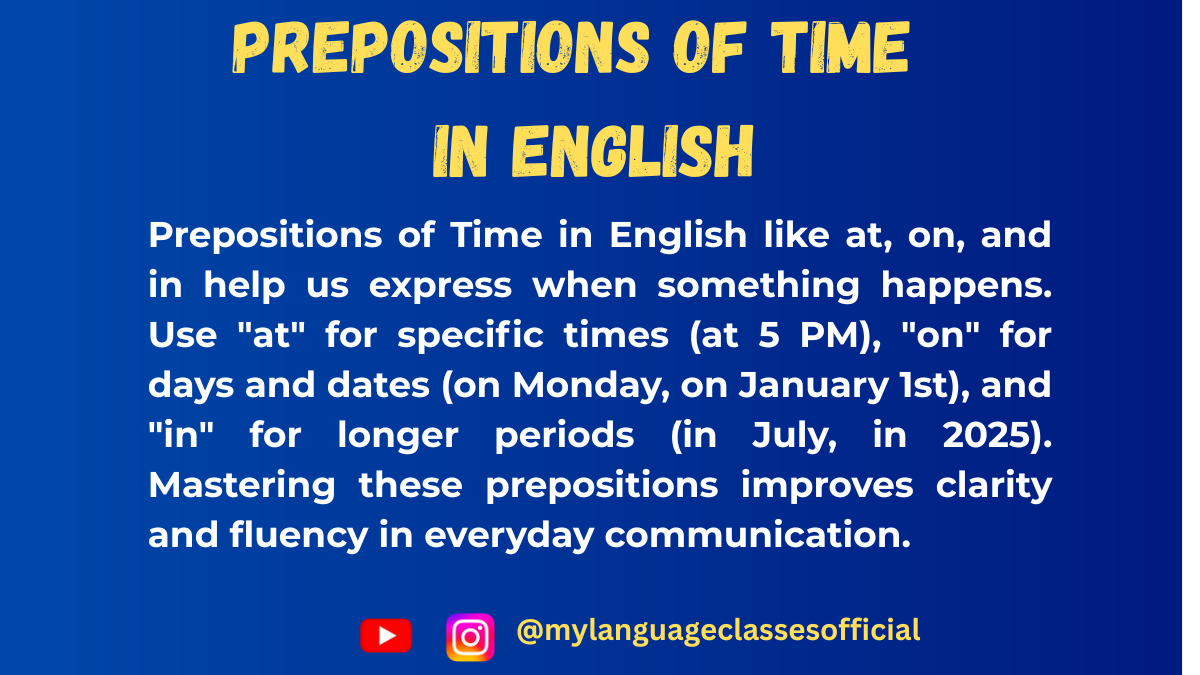
Prepositions of Time in English
Prepositions of time are essential in English grammar as they help us understand when an event occurs. They connect nouns or pronouns with time-related elements, clarifying specific moments, durations, or general time frames. In this blog, we will explore the different prepositions of time, their usages, examples, and important points to remember.
List of Prepositions of Time and Their Usage
Below is a list of common prepositions of time along with their specific usage and example sentences.
Preposition Usage Example Sentence 1 Example Sentence 2 At Specific time of the day, festivals, and specific points in time I wake up at 6 AM. We will meet at Christmas. On Specific days and dates I was born on Monday. The party is on 5th June. In Months, years, centuries, long periods I was born in December. We will visit Japan in 2025. By A deadline or before a certain time You must submit the report by Monday. She will be home by 7 PM. Before An event occurring earlier than a certain time Finish your work before sunset. He arrived before me. After An event occurring later than a certain time We will go out after lunch. She arrived after the meeting started. Since A point in time until now She has been here since morning. I have lived here since 2010. For Duration of time She stayed here for two weeks. I have known him for ten years. During Within a specific period He slept during the lecture. We traveled during the holidays. From…to A specific time range The shop is open from 9 AM to 5 PM. The movie runs from 6 PM to 8 PM. Until/till Up to a certain point in time Wait here until I return. The shop is open till midnight. Within Before the end of a specific period The work will be done within an hour. We will reach there within two days.
More Example Sentences
- She will call me at noon.
- The meeting is scheduled on Tuesday.
- We moved to this city in 2018.
- Complete your assignment by tomorrow.
- The baby slept before dinner.
- We will go out after the rain stops.
- She has lived here since 2015.
- He was on vacation for a month.
- The crowd cheered during the match.
- The library is open from 9 AM to 7 PM.
Things to Keep in Mind
- At is used for specific points in time, while on is for specific days and dates.
- In is used for months, years, centuries, and longer periods.
- Since refers to a specific point in time, while for is used for a duration.
- By means “no later than,” whereas before means “earlier than.”
- Until/till is used when something continues up to a point in time.
- From…to marks the beginning and end of a time period.
- During is used to indicate something happening within a specific period.
- Within suggests a task or event will occur before a given period ends.
Fill in the Blanks
- The train will arrive ___ 6 PM.
- She was born ___ March.
- We will go on a trip ___ summer vacation.
- He stayed in London ___ two years.
- You should submit the form ___ Monday.
- The lights went out ___ the movie.
- I have been waiting here ___ morning.
- We will complete the project ___ two weeks.
- They will be back home ___ midnight.
- The concert will be held ___ Friday night.
Answers
- at
- in
- during
- for
- by
- during
- since
- within
- at
- on
Conclusion
Understanding and correctly using prepositions of time is crucial for clear and precise communication. These prepositions help in framing accurate sentences, making conversations and writing more effective. By practicing their usage and remembering their specific contexts, you can enhance your command over the English language. Keep practicing, and soon, using prepositions of time will become second nature!
If you enjoyed this lesson, be sure to check out more posts like this on my blog at My Language Classes. Don’t forget to subscribe my YouTube channel and follow me on Instagram for the latest language learning tips and lessons. Leave a comment below to share your thoughts, or ask any questions you have about nouns.
Happy learning! 😊
-
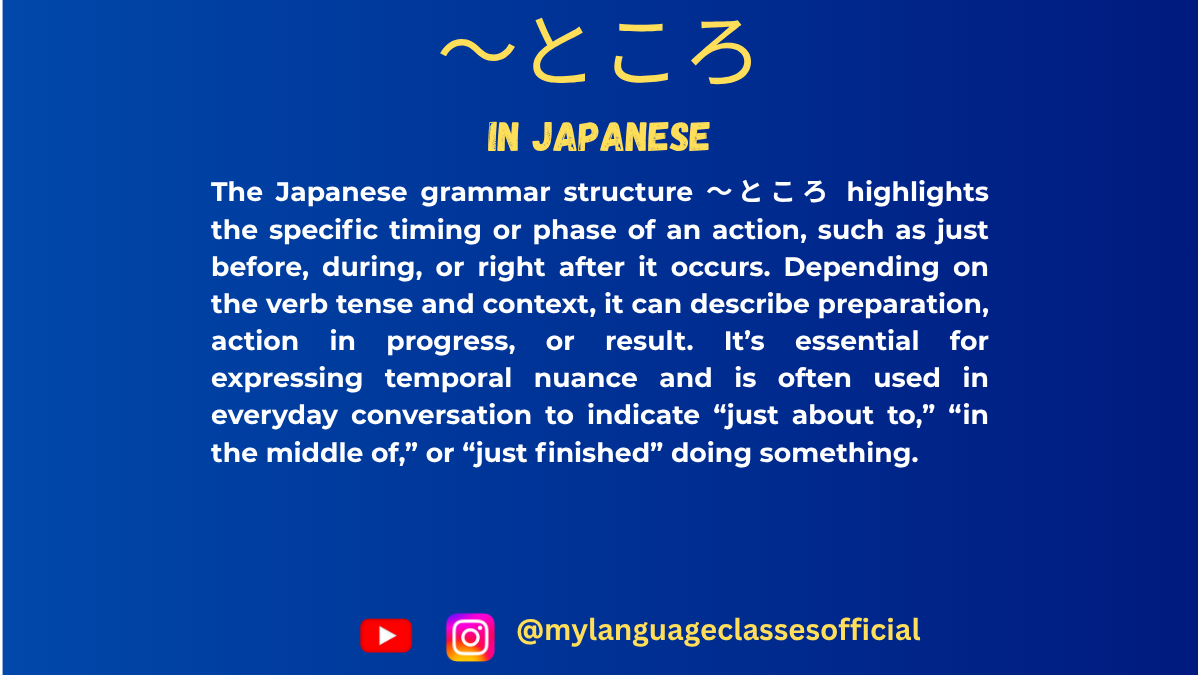
How to Use 〜ところ in Japanese | My Language Classes
Using 〜ところ Form in Japanese
The 〜ところ form is a crucial grammatical structure in Japanese that expresses different stages of an action. It helps indicate whether an action is about to happen, is in progress, or has just been completed. This blog post will cover the formation of 〜ところ for all three verb groups, its various uses, and provide example sentences, things to keep in mind, exercises, and a conclusion.
Formation of 〜ところ Form
Group 1 (Ichidan Verbs)
For ichidan (一段) verbs, remove る from the dictionary form and add the appropriate auxiliary:
- Before the action: 〜るところ
- During the action: 〜ているところ
- After the action: 〜たところ
Example:
- 食べる (taberu – to eat)
- Before: 食べるところ (taberu tokoro)
- During: 食べているところ (tabete iru tokoro)
- After: 食べたところ (tabeta tokoro)
Group 2 (Godan Verbs)
For godan (五段) verbs, use the same rules as ichidan verbs but conjugate accordingly:
- Before the action: Dictionary form + ところ
- During the action: て-form + いるところ
- After the action: た-form + ところ
Example:
- 読む (yomu – to read)
- Before: 読むところ (yomu tokoro)
- During: 読んでいるところ (yonde iru tokoro)
- After: 読んだところ (yonda tokoro)
Group 3 (Irregular Verbs)
For irregular verbs like する and くる:
- する (suru – to do)
- Before: するところ (suru tokoro)
- During: しているところ (shite iru tokoro)
- After: したところ (shita tokoro)
- くる (kuru – to come)
- Before: くるところ (kuru tokoro)
- During: きているところ (kite iru tokoro)
- After: きたところ (kita tokoro)
Usage of 〜ところ
Situations where 〜ところ is used:
Situation Form Used Example Right before an action るところ 今から寝るところです。 (I’m just about to sleep.) In the middle of an action ているところ ちょうど宿題をしているところです。 (I am in the middle of doing my homework.) Just after an action たところ ちょうどご飯を食べたところです。 (I just finished eating.) To indicate an important moment る・ている・たところ 試験を受けるところだった。(I was just about to take the exam.) When explaining a sequence of events たところ 先生に聞いたところ、すぐに答えがわかった。(When I asked the teacher, I immediately understood the answer.)
Example Sentences
- 電車が出発するところです。
Densha ga shuppatsu suru tokoro desu.
(The train is about to depart.) - 彼は今、電話しているところです。
Kare wa ima, denwa shite iru tokoro desu.
(He is on the phone right now.) - ちょうど昼ご飯を食べたところです。
Choudo hirugohan o tabeta tokoro desu.
(I just finished eating lunch.) - 飛行機が今にも飛ぶところです。
Hikouki ga ima ni mo tobu tokoro desu.
(The airplane is just about to take off.) - 友達と話しているところでした。
Tomodachi to hanashite iru tokoro deshita.
(I was in the middle of talking with my friend.) - 彼に聞いたところ、すぐに答えてくれました。
Kare ni kiita tokoro, sugu ni kotaete kuremashita.
(When I asked him, he answered immediately.) - ちょうど今、家を出るところです。
Choudo ima, ie o deru tokoro desu.
(I am just about to leave home.) - 映画を見ているところです。
Eiga o mite iru tokoro desu.
(I am in the middle of watching a movie.) - 買い物が終わったところです。
Kaimono ga owatta tokoro desu.
(I just finished shopping.) - 勉強するところだったのに、友達が来ました。
Benkyou suru tokoro datta noni, tomodachi ga kimashita.
(I was about to study, but my friend came.)
Things to Keep in Mind
- 〜ところ emphasizes timing rather than the state of an action.
- Be careful not to confuse たところ with たばかり; たところ emphasizes immediate completion.
- ているところ is often used to explain ongoing actions.
- This form is frequently used with words like ちょうど (exactly, just), 今 (now), まさに (precisely).
Fill in the Blanks
- ちょうど今、映画を____ところです。
- 飛行機が____ところでした。
- 彼は電話を____ところです。
- 今、家を____ところです。
- 私は宿題を____ところだった。
- 友達が来たので、ちょうど出かける____だった。
- 先生に聞いた____、すぐに理解しました。
- 彼はまだ寝る____ではありません。
- ちょうどレポートを____ところでした。
- 仕事が終わった____です。
Answers
- 見ている
- 飛ぶ
- している
- 出る
- する
- ところ
- ところ
- ところ
- 書く
- ところ
Conclusion
The 〜ところ form is an essential grammar point that helps clarify the timing of an action. Whether something is about to happen, currently happening, or has just happened, understanding how to use 〜ところ correctly will significantly improve your Japanese fluency. Keep practicing, and soon this structure will become second nature in your conversations!
If you enjoyed this lesson, be sure to check out more posts like this on my blog at My Language Classes. Don’t forget to subscribe my YouTube channel and follow me on Instagram for the latest language learning tips and lessons. Leave a comment below to share your thoughts, or ask any questions you have about nouns.
Happy learning! 😊
-

Use of Infinitive After Prepositions in Spanish
In Spanish, when a verb follows a preposition, it must always be in its infinitive form. Unlike English, where the gerund (-ing form) is often used after prepositions, Spanish strictly requires the infinitive. Understanding this grammatical rule is essential for forming correct sentences and sounding natural in Spanish.
This blog post will cover the different situations in which the infinitive is used after prepositions, common expressions with their meanings and examples, and essential points to keep in mind while using them.
Situations Where the Infinitive is Used After Prepositions
- Purpose or Goal (para + infinitive)
- Used to indicate the purpose or objective of an action.
- Example: Estudio para aprender. (I study to learn.)
- Means or Manner (con + infinitive)
- Expresses the way in which something is done.
- Example: Mejorarás con practicar. (You will improve by practicing.)
- Cause or Reason (por + infinitive)
- Indicates the reason for an action.
- Example: Me castigaron por llegar tarde. (They punished me for arriving late.)
- Condition (de + infinitive)
- Expresses conditions in certain phrases.
- Example: De saberlo, te lo habría dicho. (Had I known, I would have told you.)
- After Prepositions of Time (antes de/después de + infinitive)
- Used when referring to actions occurring before or after another action.
- Example: Voy a ducharme después de correr. (I am going to shower after running.)
- Prepositions Indicating a Point of Reference (sin, hasta, en, etc.)
- Used in fixed expressions and idiomatic phrases.
- Example: No puedes salir sin avisar. (You can’t leave without letting us know.)
Common Expressions with Infinitives After Prepositions
Expression Meaning Example 1 Example 2 Para estudiar To study Voy a la biblioteca para estudiar. Uso aplicaciones para estudiar español. Por llegar tarde For arriving late Me regañaron por llegar tarde. Perdí el tren por salir tarde. Con practicar By practicing Mejoras con practicar cada día. Con practicar, hablas mejor. Antes de dormir Before sleeping Leo antes de dormir. Me lavo la cara antes de dormir. Después de comer After eating Me cepillo los dientes después de comer. Llamó después de almorzar. Sin avisar Without warning No puedes irte sin avisar. Entró sin avisar. Hasta terminar Until finishing No salgo hasta terminar la tarea. No puedo descansar hasta terminar. De saberlo Had I known De saberlo, no lo habría hecho. De saberlo antes, te habría avisado. En aprender In learning Invierto tiempo en aprender español. Me esfuerzo en aprender bien. A pesar de fallar Despite failing Sigo intentándolo a pesar de fallar. Aprobó a pesar de fallar el primer intento.
More Example Sentences
- Fui al mercado para comprar frutas.
- No puedes entrar sin pagar la entrada.
- Me llamó después de haber terminado el trabajo.
- Logró su meta con dedicarse al estudio.
- Antes de salir, revisa tu mochila.
- Me fui temprano por evitar el tráfico.
- No puedes dormir sin apagar la luz.
- No podré jugar hasta mejorar mi salud.
- De haber sabido la verdad, habría reaccionado diferente.
- A pesar de tener miedo, enfrentó la situación.
Fill in the Blanks
- Voy al gimnasio ________ estar en forma. (para)
- Me castigaron ________ decir una mentira. (por)
- No puedes viajar ________ tu pasaporte. (sin)
- Voy a descansar ________ trabajar todo el día. (después de)
- No saldré ________ terminar el proyecto. (hasta)
- Aprendí español ________ estudiar mucho. (con)
- De ________ que vendrías, habría preparado algo especial. (saber)
- Siempre leo un libro ________ dormir. (antes de)
- Se esforzó mucho ________ ganar el premio. (para)
- Consiguió su objetivo ________ muchos intentos fallidos. (a pesar de)
Answers
- para
- por
- sin
- después de
- hasta
- con
- saber
- antes de
- para
- a pesar de
Things to Keep in Mind
- The verb after the preposition always remains in its infinitive form.
- Prepositions like para, por, sin, antes de, and después de commonly appear before infinitives.
- In cases where an article (el, la, los, las) is used, ensure agreement in gender and number.
- Some phrases change meaning slightly depending on the preposition used (e.g., por estudiar vs. para estudiar).
Conclusion
Using the infinitive after prepositions is a fundamental rule in Spanish. Unlike English, which often uses gerunds, Spanish requires the verb to stay in its base form. Mastering this concept will improve fluency and accuracy in constructing sentences. Practice with the expressions provided, and soon, this rule will become second nature in your Spanish conversations!
If you enjoyed this lesson, be sure to check out more posts like this on my blog at My Language Classes. Don’t forget to subscribe my YouTube channel and follow me on Instagram for the latest language learning tips and lessons. Leave a comment below to share your thoughts, or ask any questions you have.
Happy learning! 😊
- Purpose or Goal (para + infinitive)
